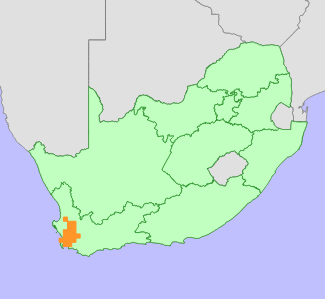|
Scientific Name | Oedera fruticosa (L.) N.G.Bergh |
Higher Classification | Dicotyledons |
Family | ASTERACEAE |
Synonyms | Anthemis fruticosa L., Relhania ericoides (P.J.Bergius) Cass., Relhania fruticosa (L.) K.Bremer |
National Status |
Status and Criteria | Near Threatened B1ab(i,ii,iii,iv,v) |
Assessment Date | 2013/01/09 |
Assessor(s) | N.A. Helme & L. von Staden |
Justification | This species has an extent of occurrence (EOO) of 10 065 km², between 15 and 25 locations remain after more than 85% loss of this species' lowland renosterveld habitat to urban and agricultural expansion. It continues to decline due to ongoing habitat loss and degradation. It is therefore assessed as Near Threatened under criterion B. |
Distribution |
Endemism | South African endemic |
Provincial distribution | Western Cape |
Range | It is found from Piketberg to Gordon's Bay and Wolseley. |
Habitat and Ecology |
Major system | Terrestrial |
Major habitats | Swartland Shale Renosterveld, Breede Shale Renosterveld, Peninsula Shale Renosterveld, Swartland Granite Renosterveld, Swartland Silcrete Renosterveld, Matjiesfontein Quartzite Fynbos, Cape Winelands Shale Fynbos, Breede Shale Fynbos, Boland Granite Fynbos, Cape Flats Sand Fynbos, Atlantis Sand Fynbos, Lourensford Alluvium Fynbos, Swartland Alluvium Fynbos, Breede Alluvium Fynbos, Kouebokkeveld Alluvium Fynbos |
Description | Plants grow in seasonally damp clay soils in lowland renosterveld. |
Threats |
| Less than 15% of this species' lowland renosterveld habitat remains following loss predominantly to crop cultivation, but also urban expansion. Small remaining fragments continue to decline and degrade due to alien plant invasion, a lack of fire, overgrazing and ongoing loss to agricultural and urban expansion. |
Population |
A formerly widespread and abundant species, Oedera fruticosa is still common in lowland renosterveld fragments, where it can often be one of the dominant species.
|
Population trend | Decreasing |
Assessment History |
Taxon assessed |
Status and Criteria |
Citation/Red List version | | Relhania fruticosa (L.) K.Bremer | Least Concern | 2012.1 | | Relhania fruticosa (L.) K.Bremer | Least Concern | Raimondo et al. (2009) | |
Bibliography |
Bremer, K. 1976. The genus Relhania (Compositae). Opera Botanica 40:1-85.
Goldblatt, P. and Manning, J.C. 2000. Cape Plants: A conspectus of the Cape Flora of South Africa. Strelitzia 9. National Botanical Institute, Cape Town.
Raimondo, D., von Staden, L., Foden, W., Victor, J.E., Helme, N.A., Turner, R.C., Kamundi, D.A. and Manyama, P.A. 2009. Red List of South African Plants. Strelitzia 25. South African National Biodiversity Institute, Pretoria.
Stafford, G.I., Wikkelso, M.J., Nancke, L., Jager, A.K., Moller, M. and Ronsted, N. 2016. The first phylogenetic hypothesis for the southern African endemic genus Tulbaghia (Amaryllidaceae, Allioideae) based on plastid and nuclear DNA sequences. Botanical Journal of the Linnean Society 181:156–170.
|
Citation |
| Helme, N.A. & von Staden, L. 2013. Oedera fruticosa (L.) N.G.Bergh. National Assessment: Red List of South African Plants version 2024.1. Accessed on 2025/10/26 |
 Comment on this assessment
Comment on this assessment

